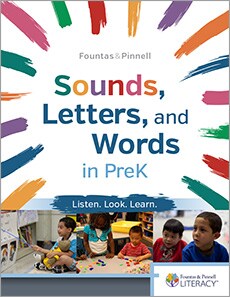Children will learn intentionally as they ––
PLAY word, letter, and sound games, sing songs, and engage in joyful poetry
INQUIRE and participate in play and conversation as they develop early literacy concepts, letter knowledge, and phonological awareness
DISCOVER the fascinating related worlds of oral language and written language
LESSONS ARE ORGANIZED IN THE RECOMMENDED SEQUENCE
Together, the lessons in this resource reflect the concepts that most prekindergarteners need to learn in preparation for reading continuous text. They are presented by suggested time periods across the year and organized into these categories:
- Learning About Print: Words
- Learning How Print Works
- Hearing Words That Rhyme
- Learning About Print: Letters
- Hearing and Recognizing Words
- Hearing Syllables
- Hearing Phonemes
EACH LESSON FOLLOWS A SIMPLE STRUCTURE
Teach and Try The lesson is presented step-by-step and taught in a whole-group setting that engages PreK children.
Practice Children work individually, with partners, in small groups, or with the whole class to practice what they’ve learned in the lesson.
More Ways to Learn and Play Provide additional practice with quick, optional extension activities.
Notice Find evidence of children’s learning through informative questions.

